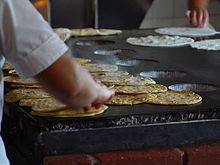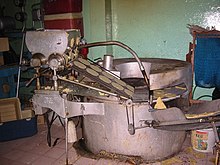Corn tortilla: Difference between revisions
RichardWeiss (talk | contribs) Undid revision 144227687 by 68.189.78.216 (talk) |
RichardWeiss (talk | contribs) rm word flour as is default and replace cooked with heated they dont look cooked to me |
||
| Line 1: | Line 1: | ||
{{otheruses4|the Mexican Tortilla|the Spanish Tortilla|Tortilla de patatas}} |
{{otheruses4|the Mexican Tortilla|the Spanish Tortilla|Tortilla de patatas}} |
||
[[Image:FlourTortillas.jpg|right|thumb|Two |
[[Image:FlourTortillas.jpg|right|thumb|Two heated tortillas.]] |
||
In [[Mexico]], [[Central America]], the [[United States]], and [[Canada]], a ''tortilla'' is a kind of thin, [[leavening|unleavened]] flat [[bread]], made from finely ground [[maize]] (corn) or [[wheat]] [[flour]]. The maize version is the original North American tortilla and is regarded by many as the "authentic" tortilla. However, it would be inaccurate to discount flour tortillas as "inauthentic," as flour tortillas originated in regions of Mexico unsuited for growing corn. In fact, this form of bread pre-dates the arrival of Europeans to America, and was only called "tortilla" by the Spanish from its resemblance to the traditional Spanish round unleavened cakes and [[omelette]]s (originally made without potatoes, which are native to South America). |
In [[Mexico]], [[Central America]], the [[United States]], and [[Canada]], a ''tortilla'' is a kind of thin, [[leavening|unleavened]] flat [[bread]], made from finely ground [[maize]] (corn) or [[wheat]] [[flour]]. The maize version is the original North American tortilla and is regarded by many as the "authentic" tortilla. However, it would be inaccurate to discount flour tortillas as "inauthentic," as flour tortillas originated in regions of Mexico unsuited for growing corn. In fact, this form of bread pre-dates the arrival of Europeans to America, and was only called "tortilla" by the Spanish from its resemblance to the traditional Spanish round unleavened cakes and [[omelette]]s (originally made without potatoes, which are native to South America). |
||
Revision as of 18:15, 12 July 2007
In Mexico, Central America, the United States, and Canada, a tortilla is a kind of thin, unleavened flat bread, made from finely ground maize (corn) or wheat flour. The maize version is the original North American tortilla and is regarded by many as the "authentic" tortilla. However, it would be inaccurate to discount flour tortillas as "inauthentic," as flour tortillas originated in regions of Mexico unsuited for growing corn. In fact, this form of bread pre-dates the arrival of Europeans to America, and was only called "tortilla" by the Spanish from its resemblance to the traditional Spanish round unleavened cakes and omelettes (originally made without potatoes, which are native to South America).
The Spanish word tortilla [torˈtiʝa] denotes two different classes of foods, depending on where the term is encountered. Etymologically, it is derived from the word torta, meaning a plain round cake.[1]
In Spain and South America, a tortilla is a round, layered omelette (i.e., not folded over), most typically made with layers of eggs, very thinly sliced potatoes, such seasonings as the chef desires, and cooked in vegetable oil. It is usually served cold as an appetizer or bar snack. The terms Spanish tortilla, tortilla española or tortilla de patatas all refer to a common recipe in Spain, an omelette with stir-fried potatoes and chopped onion, often served as a staple food in Spanish bars and cafés. American versions of Spanish and South American tortilla are usually cooked in vegetable shortening, commonly with bell pepper and/or onion and/or chives; and typically served warm instead of cold.
But it is the Mexican meaning of "tortilla" that is most familiar to North Americans, and possibly most of the world outside of Europe and South America, where the original Spanish meaning is best known.
The flour tortilla is probably best known in the USA as the tortilla used to make burritos, a preparation originating in northern Mexico. Wheat tortillas are also a traditional staple of the peoples of northwestern Mexican states (such as Sonora and Chihuahua) and many southwestern US Native American tribes. As an easy solution to both the problems of handling food in microgravity and preventing bread crumbs from escaping into delicate instruments, wheat flour tortillas have been used on many NASA Shuttle missions since 1985. [1]
Maize tortillas are known in the Basque region of Spain as talo and were a traditional Basque farmers' staple until the introduction of railborne wheat flour suitable for bread. There are maize tortillas in other regions of Northern Spain, such Asturias, where they are called frixuelos, and Galicia, where they receive the name of filloas.
Tortilla making

The traditional tortilla has been made of corn or maize since Pre-Columbian times. It is made by curing maize in lime water in a process known as nixtamalization which causes the skin of the corn kernels to peel off (the waste material is typically fed to poultry), then grinding and pre-cooking it, kneading it into a dough called masa nixtamalera, pressing it flat into thin patties, and cooking it on a very hot comal (originally a flat terra cotta griddle, now usually made instead of light sheet-metal).
Soaking the maize in water is important because it liberates the vitamin niacin and the amino acid tryptophan. When maize was brought back to Europe, Africa and Asia from the New World, people left out this crucial step. People whose diet consisted mostly of corn meal often became sick, because of the lack of niacin and tryptophan, with the disease pellagra, which was common in Spain, Northern Italy and the southern United States.
In Mexico, particularly in the towns and cities, most corn tortillas are nowadays made by machine and are very thin and uniform, but in Belize, El Salvador, Guatemala, or Honduras they are still often made by hand and are thicker. Corn tortillas are customarily served and eaten warm; when cool, they often acquire a rubbery texture. The largest tortilla producer in the world is a Mexican company called Gruma, headquartered in Monterrey.
Traditionally throughout Mesoamerica from Pre-Columbian times into the mid 20th century, the masa was prepared by women using a mano (a cylinder shaped stone like a rolling pin) and metate (a stone base with a slightly concave top for holding the corn).
The wheat flour tortilla was an innovation after wheat was brought to the New World from Spain while this region was the colony of New Spain. It is made with an unleavened, water based dough, pressed and cooked like corn tortillas. These tortillas are very similar to the unleavened bread popular in Arab, eastern Mediterranean and southern Asian countries, though thinner and smaller in diameter. In China, there is the laobing (烙餅), a pizza-shaped thick "pancake" that is similar to the tortilla. The Indian Roti, which is made essentially from wheat flour is another example.

Tortillas vary in size from about 6 to over 30 cm (2.4 to over 12 in), depending on the region of the country and the dish for which it is intended.
Among tortilla variants (without being, strictly speaking, tortillas) there are pupusas, "pishtones, gorditas, sopes, and tlacoyos. These filled snacks can be found in Mexico, Belize, Guatemala, El Salvador and Honduras. They are smaller, thicker versions to which beans, chicharrón, nopales or other ingredients have been added. They are customarily cooked on a greased pan.
In Nicaragua their version is called Güirila its made from young white corn and the güirilas are thick, sweet and filling. They are enjoyed as a snack by itself, with crumbled cheese, or accompanying a dish.
In Argentina, Bolivia and southern Chile, the size of the tortillas is smaller. They are generally saltier, made from wheat or corn flour, and roasted in the ashes of a traditional adobe oven. This kind of tortilla is called Sopaipilla (not to be confused with a puffy fry bread of the same name common in New Mexico, United States). In Chile and Argentina it may also be sweetened after being cooked by boiling in sugar water.

In commercial production and even in some larger restaurants, automatic machines make tortillas from dough.
A simple tortilla recipe:
4 C flour 1/2 C shortening 1 t salt 1 C warm water
Mix 2 C flour, all of the shortening and salt until the mixture has the consistency of small crumbles. Add warm water. Mixture will be sticky. Add remaining flour and knead until dough is pliable and springy. May not need all of the flour. Let sit covered for a minimum of one hour. Take small portions and form a ball. Roll out with rolling pin and cook over medium heat on a cast iron skillet until brown spots form.
See also
References
- ^ torta in Diccionario de la Real Academia Española.
